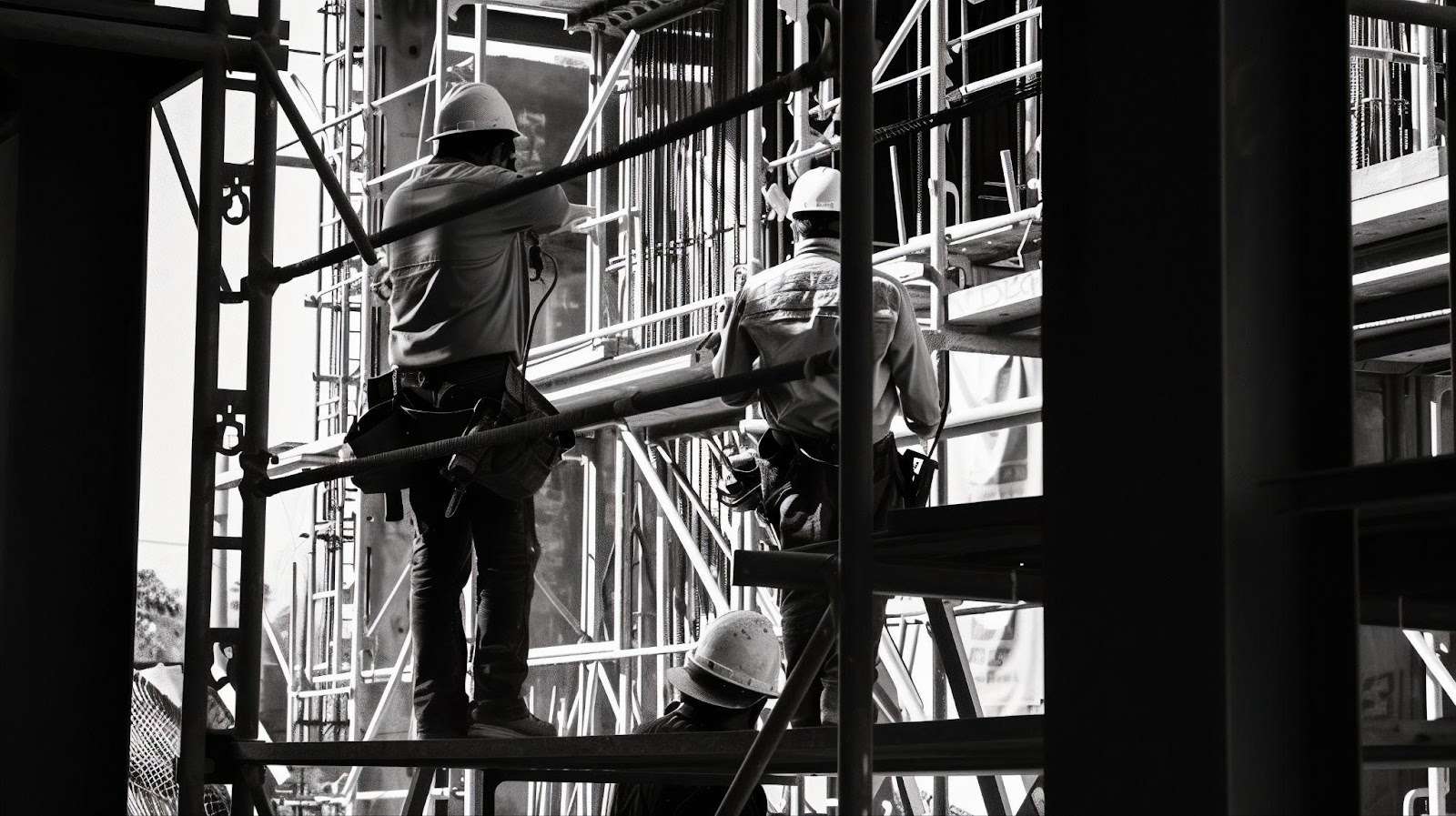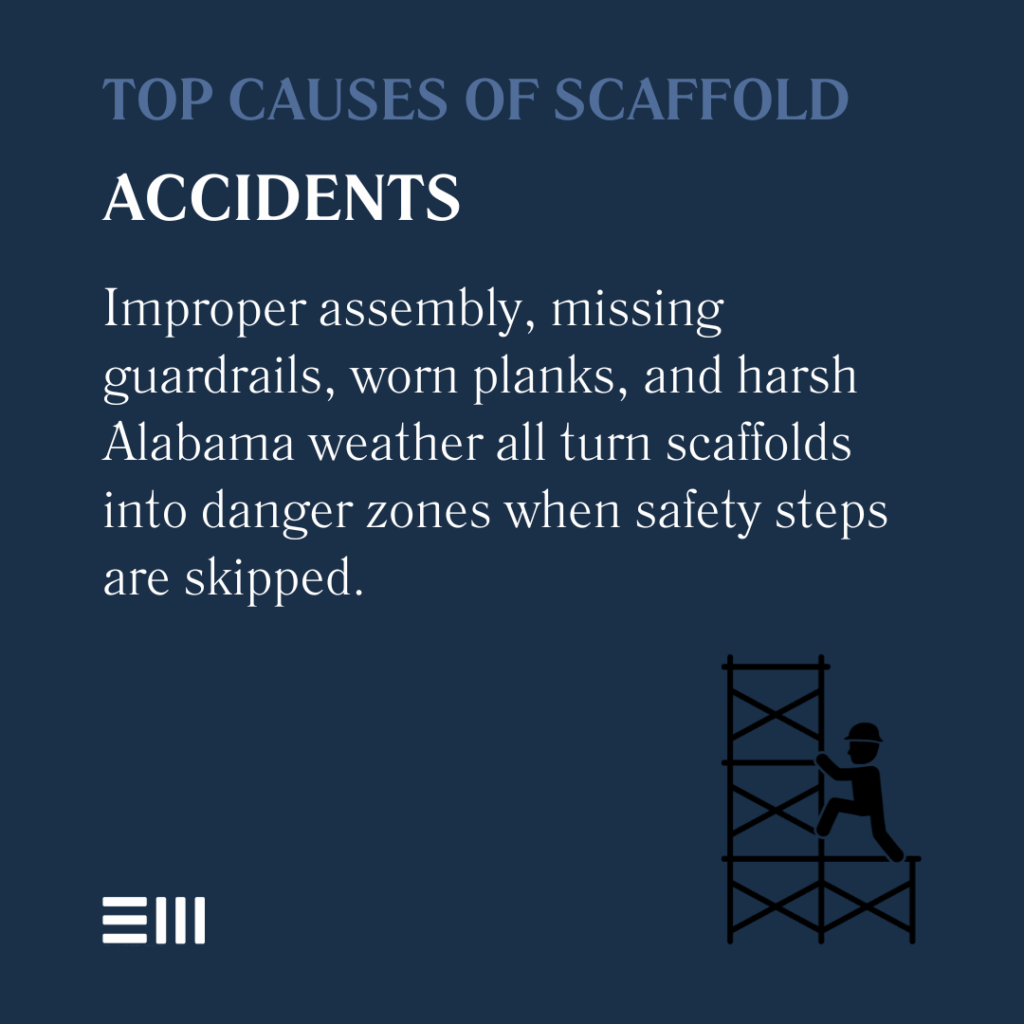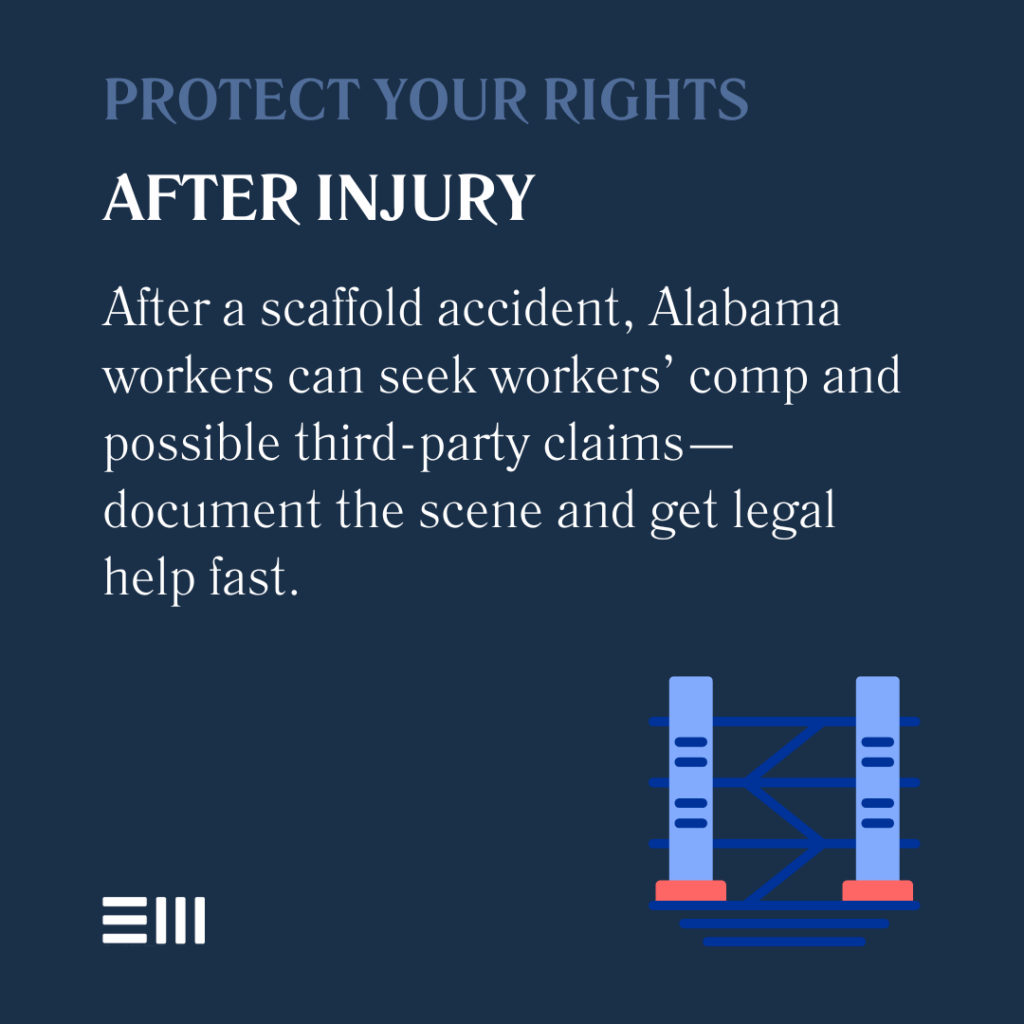
Falls from scaffolds remain one of construction’s “Fatal Four” hazards identified by OSHA, claiming workers’ lives and causing devastating injuries across Alabama job sites each year.
These elevated platforms, essential for reaching high work areas from Birmingham high-rises to Mobile shipyards, transform from productivity tools into danger zones when safety protocols fail or equipment deteriorates.
Understanding Scaffold Hazards in Construction
Scaffolding serves as the backbone of construction projects throughout Alabama, from Birmingham high-rises to Mobile shipyards. These temporary structures enable workers to perform tasks at dangerous heights, but their very purpose creates inherent risks. The combination of elevation, heavy materials, and multiple workers sharing limited space demands constant vigilance and proper safety measures.
When any element of scaffold safety breaks down—whether through human error, equipment failure, or environmental factors—the consequences often prove catastrophic for workers and their families.
Primary Causes of Scaffold Accidents
Alabama construction sites face numerous scaffold-related dangers that lead to preventable accidents.
Understanding these primary causes helps workers recognize hazards and employers implement better safety protocols.
#1: Improper Assembly and Installation
Scaffold assembly requires precision and expertise that many job sites overlook in their rush to meet deadlines.
Common assembly errors include missing cross-braces, inadequate base plates, incorrect coupling pins, improper planking overlap, and unstable foundations.
Workers often face pressure to construct scaffolds quickly, leading to shortcuts that compromise structural integrity. These assembly failures frequently remain hidden until weight or movement stresses the system beyond its compromised capacity.
#2: Inadequate Fall Protection Systems
Falls from scaffolds account for the majority of serious injuries and fatalities on construction sites. Fall protection failures typically involve missing guardrails on open sides, gaps in planking exceeding
allowable limits, absent or improperly installed toeboards, lack of personal fall arrest systems, and inadequate safety net systems.
The absence of proper fall protection transforms routine work into life-threatening situations, especially when workers must lean beyond scaffold edges or carry materials across platforms.
#3: Material and Equipment Failures
Scaffold components endure tremendous stress from weather, weight, and repeated use across multiple projects.
Equipment failures often stem from corroded metal components, cracked or rotting wooden planks, damaged locking mechanisms, worn coupling devices, and overloaded platforms exceeding weight ratings.
Regular inspection and maintenance could prevent many equipment failures, but cost-cutting measures and time pressures often lead to continued use of compromised materials.
#4: Environmental and Weather Conditions
Alabama’s climate creates unique challenges for scaffold safety throughout the year. Weather-related hazards include high winds destabilizing tall scaffolds, rain creating slippery surfaces, ice formation during winter months, lightning risks during storms, and extreme heat affecting worker alertness.
Employers must monitor weather conditions and implement appropriate safety measures, including work stoppages when conditions become too dangerous for scaffold use.
Each of these primary causes represents preventable risks that proper training, equipment maintenance, and safety protocols can significantly reduce.

Secondary Contributing Factors
Beyond the primary causes, several additional factors increase the likelihood and severity of scaffold accidents on Alabama job sites. These secondary issues often compound primary hazards, creating especially dangerous conditions.
Insufficient worker training remains a persistent problem across construction sites. Many workers receive minimal scaffold-specific safety education before ascending these structures.
Communication barriers further complicate safety efforts when crew members speak different languages or work for different subcontractors. Rushed project timelines pressure workers to skip safety checks or work in hazardous conditions.
Poor lighting, especially during early morning or evening hours, obscures potential hazards. Lack of proper supervision allows unsafe practices to continue unchecked until accidents occur.
These contributing factors demonstrate how scaffold accidents rarely result from single causes but rather from combinations of hazards and safety failures.
Legal Rights After Scaffold Accidents
Workers injured in scaffold accidents possess important legal rights under Alabama law and federal regulations. Understanding these rights helps injured workers secure proper compensation and medical care for their construction site injuries.
Alabama’s workers’ compensation system provides immediate medical benefits and wage replacement for most scaffold accidents, regardless of fault. However, third-party claims may apply when scaffold manufacturers, property owners, or other contractors contributed to unsafe conditions.
OSHA violations documented after accidents strengthen injury claims and may result in additional penalties against employers. Injured workers should document all circumstances surrounding their accidents, including photographs, witness statements, and safety violation reports.
The complexity of construction site liability often requires legal expertise to identify all responsible parties and available compensation sources for injured workers.

Prevention and Safety Measures
Preventing scaffold accidents requires comprehensive safety programs that address equipment, training, and ongoing hazard monitoring. Effective prevention strategies protect workers while improving overall job site productivity.
Successful scaffold safety programs include daily pre-use inspections by competent persons, mandatory safety training for all workers using scaffolds, proper personal protective equipment requirements, clear weight limit posting and enforcement, and regular equipment maintenance schedules.
Employers should establish clear communication channels for reporting unsafe conditions without fear of retaliation. Written safety plans specific to each scaffold configuration ensure consistent implementation of protective measures.
Investment in scaffold safety pays dividends through reduced accidents, lower insurance costs, and improved worker morale across construction projects.
Frequently Asked Questions About Scaffold Accidents on Job Sites
Understanding common concerns about scaffold accidents helps injured workers and their families make informed decisions about safety and legal rights.
What Should I Do Immediately After a Scaffold Accident?
Seek immediate medical attention even for seemingly minor injuries, as some conditions worsen over time. Report the accident to supervisors and ensure proper documentation occurs. Photograph the accident scene, including equipment conditions and any visible hazards. Collect contact information from witnesses before they leave the job site. Avoid signing any documents or giving recorded statements without legal counsel.
How Long Do I Have to File a Scaffold Accident Claim in Alabama?
Alabama law establishes specific deadlines for different types of claims. Workers’ compensation claims generally require notice to employers within five days and filing within two years. Third-party lawsuits against manufacturers or other contractors typically must be filed within two years of the injury. These deadlines vary based on specific circumstances, making prompt legal consultation essential.
Can I Sue My Employer for a Scaffold Accident?
Workers’ compensation generally provides the exclusive remedy against direct employers in Alabama. However, lawsuits may be possible against third parties, including scaffold manufacturers, property owners, or general contractors. Gross negligence or intentional safety violations may create exceptions to workers’ compensation exclusivity. Each case requires individual analysis to determine all available legal options.
What Compensation Is Available for Scaffold Accident Injuries?
Compensation varies based on injury severity and applicable legal claims. Workers’ compensation provides medical expenses, temporary disability benefits, and permanent impairment awards. Third-party claims may include pain and suffering, lost earning capacity, and punitive damages. Fatal accidents may provide death benefits to surviving family members.
How Can I Prove My Scaffold Accident Resulted from Safety Violations?
OSHA investigation reports often document specific safety violations contributing to accidents. Photographs showing missing safety equipment or improper assembly support violation claims. Expert witnesses can analyze accident circumstances and identify regulatory violations. Maintenance records and inspection reports reveal patterns of safety neglect.
These questions represent starting points for understanding scaffold accident claims, with each situation requiring detailed legal analysis.
Let Justice Roll
Scaffold accidents shatter lives in seconds, leaving workers facing painful injuries, mounting medical bills, and uncertain futures. You deserve aggressive legal representation that understands construction site dangers and fights for maximum compensation.
Our experienced personal injury attorneys here at Baxley Maniscalco have helped countless Alabama construction workers navigate the complex legal landscape following scaffold accidents.
We investigate every aspect of your accident, identify all responsible parties, and pursue every available source of compensation. Our team understands the construction industry, OSHA regulations, and Alabama injury law.
Don’t let insurance companies or employers minimize your injuries or deny rightful compensation.
Contact us today for a free consultation about your scaffold accident case. Call our office or complete our online form to speak with an attorney who will fight for the justice and compensation you deserve.
Can't find what you're looking for? Search our site below.










